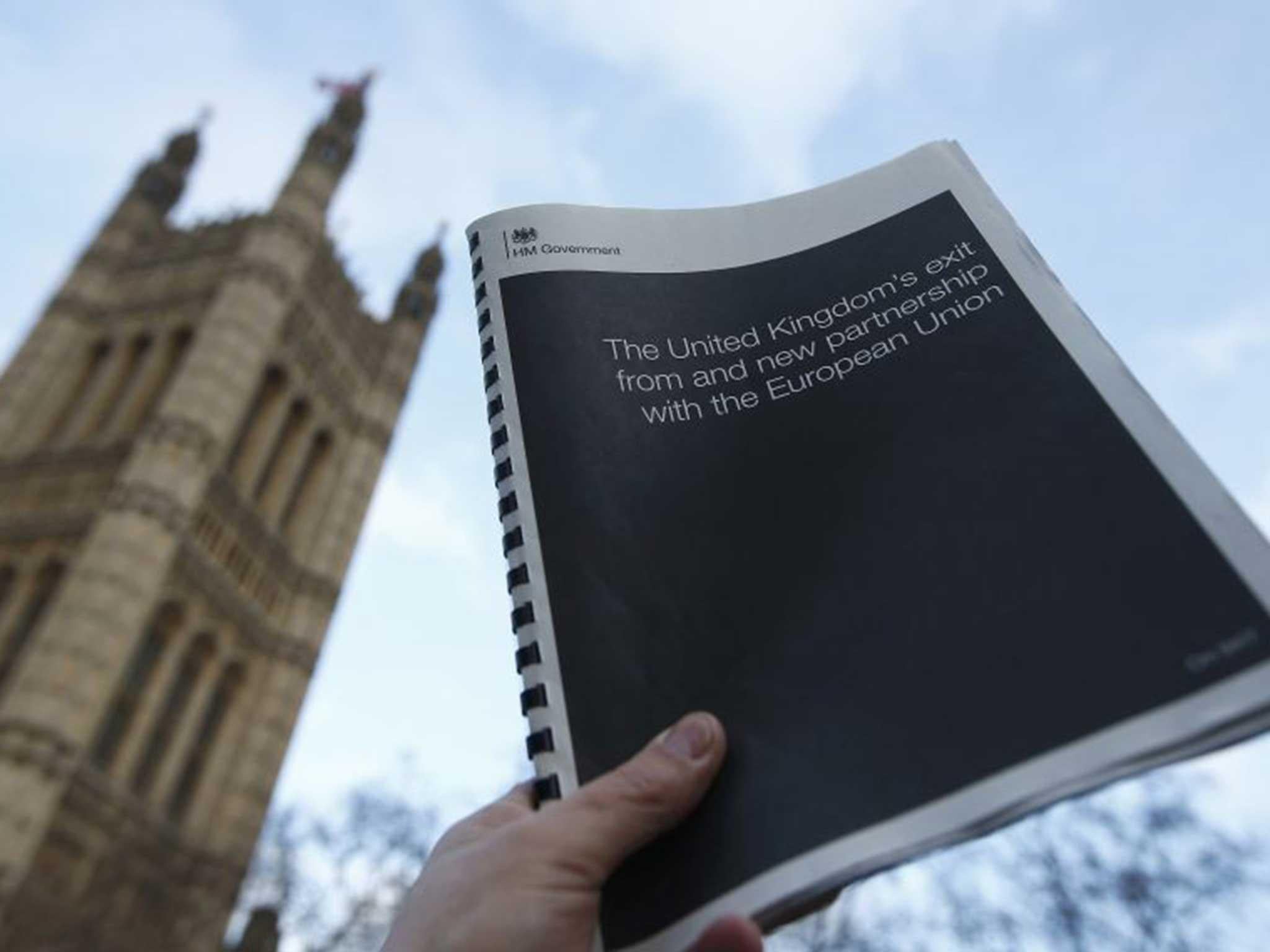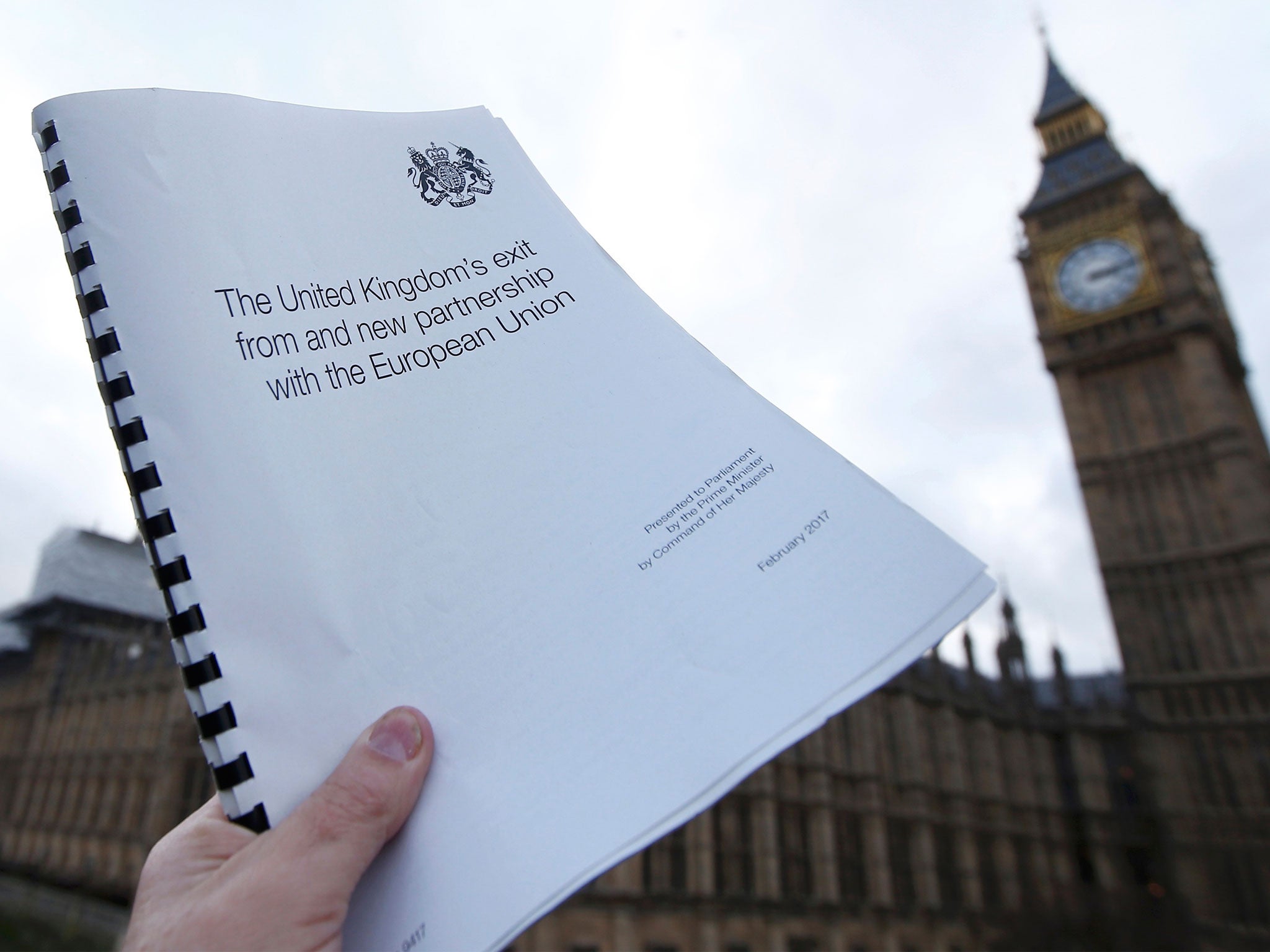At last, White Paper sets out 12 key Brexit goals. Now for the 12 key unanswered questions
The Government has laid out its plans for leaving the EU, but the much-anticipated document is unlikely to appease critics. Sean O’Grady and John Rentoul decode the spin

Your support helps us to tell the story
From reproductive rights to climate change to Big Tech, The Independent is on the ground when the story is developing. Whether it's investigating the financials of Elon Musk's pro-Trump PAC or producing our latest documentary, 'The A Word', which shines a light on the American women fighting for reproductive rights, we know how important it is to parse out the facts from the messaging.
At such a critical moment in US history, we need reporters on the ground. Your donation allows us to keep sending journalists to speak to both sides of the story.
The Independent is trusted by Americans across the entire political spectrum. And unlike many other quality news outlets, we choose not to lock Americans out of our reporting and analysis with paywalls. We believe quality journalism should be available to everyone, paid for by those who can afford it.
Your support makes all the difference.Theresa May yesterday finally delivered on the Government’s promise of a White Paper on its plan for Brexit.
The document, which runs to 75 pages, fleshes out some of the “12 Principles” outlined in Ms May’s keynote speech at Lancaster House last month.
It is, in essence, the concession government whips offered to parliamentary critics, including within Conservative ranks, to ensure the safe passage of the bill to trigger Article 50 in its initial stages in the House of Commons.
The White Paper covers such crucial areas as migration control, trade, sovereignty and the jurisdiction of the Court of Justice of the European Union – collectively styled “taking control of our own laws”.
As promised, it also contains some infocharts and diagrams, but also at least one egregious error and signs that it was produced in haste. A “time stamp” of 4.17am appears on one page, while a chart suggests UK workers are currently entitled to a generous 14 weeks, or three and half months’ worth of annual leave.

Critics such as former Chancellor Kenneth Clarke have already pointed out that the White Paper was released after the first parliamentary vote on related legislation – the opposite of the conventional way of conducting government business. Labour said the document “says nothing” and had been produced too late for “meaningful” scrutiny. Brexit Secretary David Davis said the UK's “best days are still to come”, outside the EU.
Within hours the White Paper was being dissected and rejected by critics on both the Eurosceptic and Europhile sides of the argument. For example, a new system to control EU migration will be phased in to give businesses time to prepare – something that has disturbed Eurosceptics who want an end to free movement from the EU almost immediately.
The new system will be designed to help fill skills shortages and welcome “genuine” students – but will not satisfy those who argue immigration is essential to provide workers for public services and boost economic growth.
Pressure groups and political opponents were quick to point to some of the key areas where the Government’s approach to the coming talks may unravel.
These negotiations have been described by the former UK Ambassador to the EU, Sir Ivan Rogers, as the most complex since the Second World War, and possibly ever.
The fear is that the White Paper may not be a sufficiently strong base for ministers and civil servants to see them to a satisfactory conclusion within the tight two-year timetable dictated by Article 50 – with the spring of 2019 the notional end point for new arrangements to be in place.

There are fears that trade with the EU will be damaged whatever the outcome of the talks. Pro-EU group Open Britain said: “The Government provides zero detail of how they will deliver trade that is as ‘frictionless as possible’ apart from a brief mention of ‘the use of digital technologies’. This is not good enough. Research from Open Britain has previously shown that this could cost UK businesses £12.7bn.”
Below are the 12 key section headings taken from the White Paper, with an analysis of each – and the big question that each section leaves unanswered:
Section 1: “Providing certainty and clarity”:
Question: When will the text of the Great Repeal Bill be published?
A Great Repeal Bill will take EU-derived law and directives and transfer them into UK law. However, there is doubt as to how easily this can easily be done in the case of EU directives that did not form part of any UK Act of Parliament. While the Government agrees that funding commitments made to the EU already will be honoured, there is no figure, or range of figures, to suggest how much. Some claim the “divorce bill” might amount to €60bn.
Section 2: “Taking control of our own laws”
Question: Will a UK-EU trade panel have the right to overrule UK law?
The Government reiterates that removing the European Court’s role in British political life, like migration, is a priority above any considerations about trade or economic prosperity (a point made in the powerful backbench speech by former Chancellor George Osborne during the Article 50 debate). Here the Government concedes that without the European Court of Justice (ECJ) some form of arbitration will be required to rule on disputes between the UK and the EU on any trade deals. However, as with so many other areas, what eventually may take the place of the ECJ has to be agreed by both sides – and that there may still be cases where a European panel can override UK laws, just as the ECJ can now.
Section 3: “Strengthening the Union”
Question: What will happen if Scotland votes for independence in 2018 or 2019?
Despite much discussion and meetings with Scottish, Welsh and Northern Irish leaders, there is no answer to the problem of how the UK Government can remove Scotland and Northern Ireland from the EU without the consent of their peoples; nor any substantive response to the Scottish government’s proposal that Scotland be allowed to remain inside the single market after Brexit.
Section 4: “Protecting our strong historic ties with Ireland and maintaining the Common Travel Area”
Question: Will there be any border controls with Ireland after 2019?
Again there is no concrete idea of how the free travel zone, which has been in place since 1921, can survive Brexit. If, say a Pole flies to Dublin and then gets a train to Belfast, he or she will have entered the UK with no formalities, leaving immigration from the EU still unrestricted in practice.
Section 5: “Controlling immigration”
Question: How many EU nationals will come to Britain after Brexit?
Despite the message that the referendum gave on immigration, and Ms May’s pledge to fulfil the expectation; there are no proposals or figures for likely migration levels post-Brexit.
Section 6: “Securing rights for EU nationals in the UK and UK nationals in the EU”
Question: What will happen to UK nationals living in Spain and elsewhere if we fail to reach agreement?
No progress: both groups remain “bargaining chips”, though British ministers blame the EU for an unwillingness to engage on the issue before Article 50 is invoked, but the White Paper does not even address the argument that the UK Government could act unilaterally.
Section 7: “Protecting workers’ rights”
Question: What will the new UK economic model look like?
No new proposals. Mrs May’s previous commitment to have workers on the boards of larger concerns has been watered down to: “We will ensure the voices of workers are heard by the boards of publicly-listed companies.” A commitment to review employment law is repeated. Moreover, there is no sense that a radical reform to the UK “economic model” – implying weaker labour laws and workers’ rights, what Jeremy Corbyn calls a “bargain basement” Britain – hinted by the Chancellor Philip Hammond and the Prime Minster is yet being pursued.
Section 8: “Ensuring free trade with European markets”
Question: What about the Leave campaigns promises to try to gain access to the single market?
The White Paper provides a useful and highly educational Euler diagram (below) illustrating the different jurisdictions of the EU, single market, customs union, eurozone, European Free Trade Association and European Economic Area, but moves Government policy no further.

Section 9: “Securing new trade agreements with other countries”
Question: What will the effect of Brexit be on the economy?
Understandably, few suggestions of where new deals will be coming from; how those with different countries can be balanced against one another; nor what impact falling back on World Trade Organisation rules – the basic framework for trade – would have on trade, investment and the economy as a whole. This is in stark contrast to the work by HM Treasury and Bank of England during the referendum campaign”.
Section 10: “Ensuring the United Kingdom remains the best place for science and innovation”
Question: Can the Government offer guarantees to universities about science funding for the decades ahead?
This section is extremely short and unlikely to appease worried universities – or indeed anyone alarmed about the threat to British science.
Section 11: “Cooperating in the fight against crime and terrorism”
Question: What will the effect of Brexit be on efforts to reduce crime and fight terrorism?
Home Secretary Amber Rudd recently gave evidence to Yvette Cooper and the Home Affairs Select Committee about how keen she was to retain the existing relationships with Europol – an EU agency – and, in particular, sharing with them intelligence about terrorist activities. And we are no clearer about whether the Government intends to remain part of the European Arrest Warrant, which Theresa May as Home Secretary claimed was vital to fighting crime..
Section 12: “Delivering a smooth, orderly exit from the EU”
Question: Are transitional arrangements an aim of policy or not?
The prospect of a “cliff-edge” exit is probably the greatest single fear shared by business and the banks. The Chancellor has previously suggested a long period of adjustment; in her speech and again in the White Paper the Prime Minster and David Davis have foreshortened this.
In what may prove a dangerous position for the Government, there was no movement in the White Paper on what Labour called a “meaningful vote” that could send the Prime Minister back to the negotiating table if the deal is deemed unsatisfactory by MPs.
So far Ms May has only offered a vote on the deal – but with no opportunity for Parliament or the people through a referendum to take the option of remaining in the EU if the terms are thought to be worse than the status quo. This has been a consistent demand of the Liberal Democrat leader Tim Farron.
With the White Paper offering further background, MPs will discuss the bill to trigger Article 50 in more detail next week when it reaches the committee stage in the Commons.
The SNP, Labour and the Liberal Democrats have tabled more than 100 pages of proposed amendments.
Amendments aimed at delivering a meaningful parliamentary vote on the eventual deal in 2019, with the option of remaining in the EU or further talks, are now likely to unite opposition and Conservative doubters.
Join our commenting forum
Join thought-provoking conversations, follow other Independent readers and see their replies
1Comments